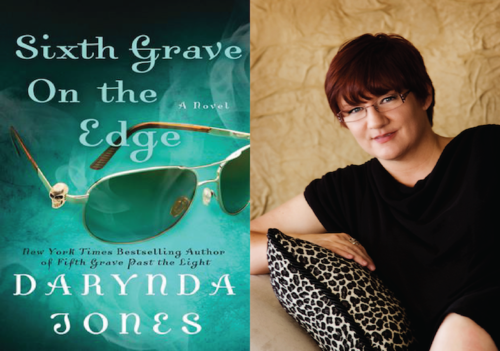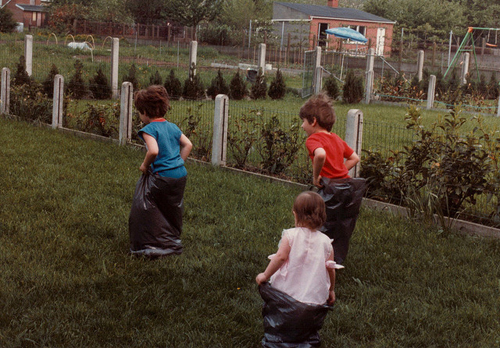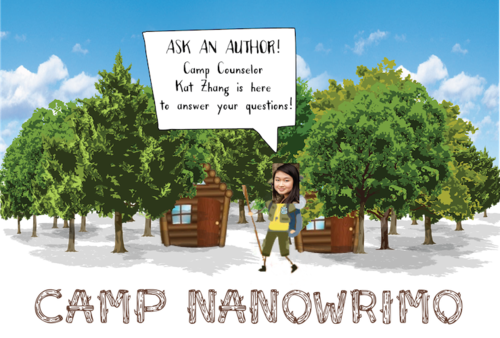Chris Baty's Blog, page 184
August 6, 2014
Wrimos Around the World: Of Bestselling Series, Nurturing Creativity, and Grim Reapers

Darynda Jones is author of the Charley Davidson series (the latest installment comes out this October!), and Darklight series. We talked about her support for the Young Writers Program and how she stays inspired to keep writing about part-time PI and full-time grim reaper Charley Davidson:
You’ve participated in NaNoWriMo since 2005. What does NaNoWriMo bring to your writing process?
I love the energy and enthusiasm that NaNoWriMo brings. It’s like static in the air, and I get excited every year to see if I can do it. I have this awesome goal without the pressure of an actual deadline, and for some reason that makes it more fun.
Now when anyone talks about November, my mind immediately jumps to NaNoWriMo, and I can hardly wait!
You’re a huge supporter of NaNoWriMo’s Young Writers Program, which supports educators, and helps students embrace creative writing in the classroom. Tell us why!
Because it’s awesome! I love with all my heart helping other writers, especially kids who think in stories. There is nothing like the imagination of a child, and nurturing that creativity is crucial. All too often, well-meaning adults squelch that creativity. I should know. I was that kid who got in trouble for daydreaming in class. Repeatedly…
I’d been making up stories since I was five. When I got older, I would write anything I could: short stories, poems, song lyrics, plays, news articles. But I never had anyone tell me I could be a writer until I was in high school and my best friend, who couldn’t help but see my passion, suggested it. Even then I thought you had to be a genius or an alcoholic to be a real writer, and I was neither. Still, I continued to write. I couldn’t not.
It took me decades to realize the desire to put words on paper would never go away, but I just feel if I’d had someone tell me much earlier that, no, I did not have to be an alcoholic to write a novel, I would have had more faith in myself at a much younger age. Not that I’m complaining! I’m certain I’m right where I’m supposed to be, but if I can help young writers, if I can inspire them in any way, or help others inspire them, I am so there.
The Young Writers Program is a way for me to help, to foster that creativity in children I could never reach on my own. I am honored to be able to give.
What inspired you to write the Charley Davidson series? And what keeps you inspired to continue writing about this private investigator/grim reaper through eight(!) books now?
Charley came about quite inorganically. I was specifically looking for a certain kind of heroine. I knew I wanted to write a continuing paranormal series and, by that point, I knew that humor would play a big part in it. It seems I can’t write without adding a sarcastic remark here and there. So, while I was lounging in bed one morning, minding my own business, Charley popped into my head. Literally. In all her glory. And I knew I had to write her story.
She keeps me inspired. She is so much fun to write it’s unreal, but I have to say that Charley’s fans keep me inspired too. They are so enthusiastic and, dare I say, rabid, they make me want to write each story better than the last.
What is your favorite trope to write about?
Ugh, I love so many! While I obviously adore the whole ‘good against evil’ thing, I am completely infatuated with the unlikely hero.
In the Charley books, she (a female PI who was born the grim reaper and gets into more trouble than a girl has a right to) is an unlikely hero in her own right, but her love interest, Reyes Farrow, is even more so. He comes from dark and violent beginnings. He is a dangerous enigma, so naturally Charley falls for him. What girl can resist such a resume? Thankfully, he overcomes his past and proves himself, and his love for Charley, daily.
If you could give writing advice to yourself when you were just starting out, what would it be?
You don’t have to love bourbon to be a writer. Just do it already!
New York Times and USA Today bestselling author Darynda Jones has won numerous awards for her work including a prestigious RITA, a Golden Heart, and a Daphne du Maurier. As a born storyteller, she grew up spinning tales of dashing damsels and heroes in distress for any unfortunate soul who happened by, annoying man and beast alike. And she’s never apologized for it. Darynda lives in the Land of Enchantment, also known as New Mexico, with her husband and two beautiful sons, the Mighty, Mighty Jones Boys.
August 1, 2014
A July 2014 Camp NaNoWriMo Wrap-Up

To all the wonderful wordsmiths out there,
Perhaps you woke up this morning and, like the past 31 days, your first thought was of your exciting, frustrating, sprawling, [insert applicable adjective here] Camp writing project. Then, in the midst of planning out the scenes you’re going to write today, you realized that July has ended, and with it this summer’s Camp session.
Check out these final Camp tidbits, as well as some ideas to keep up your momentum as we wait for November to roll around.
Camp NaNoWriMo
If you reached your word count goal, congratulations! You worked hard this month, and you deserve recognition for your amazing feat. Make sure to pick up your winner goodies under your “Camper Profile” tab.
If you didn’t reach your word count goal, you still deserve congratulations for all your hard work! You’re that much closer to finishing your project, and you can reward or inspire yourself by checking out some of our awesome sponsor offers.
Keep in mind that Cabins will close after August 4. If you want to keep any posts, etc., make sure to save them by then!
Across NaNoLandia
If you haven’t had the chance to check out the NaNoWriMo store, now is the time: we’re having an epic T-shirt clearance sale! Many shirts are now available for $10 or less—order now to make sure your size is still in stock!
It was very bittersweet for Wendy and I to host the last Virtual Write-In of the summer. If you missed it, and find yourself craving some word sprints over the coming months, don’t worry—all of the Virtual Write-Ins are archived on our YouTube channel, and you can watch the videos at any time.
In The Office
What we’re reading:
Hopscotch by Julio Cortazar - You can choose the order in which you read the chapters of this novel, making for a somewhat surreal but certainly beautiful reading experience. Gregory Rabassa won a National Book Award in 1967 for his English translation of the original.
Shades of Grey by Jasper Fforde - This funny, exciting, and overall strange tale of a surprisingly colorful post-apocalyptic world will delight and intrigue fans of Fforde’s better-known Thursday Next series.
I hate goodbyes, but I’m cheered, as I hope you are, by the fact that November’s NaNoWriMo event is a mere three months away. Would it be too cheesy to say, “It’s not goodbye, but adieu?” Probably, but I might go ahead and say it anyway.
Until next time,
Katharine
Camp Counselor
Photo by Flickr user @brunvoll.
July 31, 2014
Battling Clichés & Tired, Old Tropes: Going Home Again

It’s an age-old writers’ question: What do I do about clichés and well-worn tropes? This month, we’ve asked authors about the clichés and tropes they find themselves falling back on, and how they fix, invert, or embrace them. Today, Kristyn Kusek Lewis, author of the forthcoming
Save Me
, examines the problem of using a tired trope:
CLICHÉ: The visit back to the main character’s childhood home
You can’t go home again, or so the old saying goes. And when it comes to overused tropes, it may in fact be true. Sending your character down memory lane and straight up the front steps (or dirt road, or apartment steps) to his or her childhood home is a device that writers love and for good reason.
Even the most well-adjusted of us know that a trip home is fraught with emotion and ripe for examination, which may explain why entire novels have been written on the premise of a homecoming. There are the tricky family ties, the threats of running into the people who knew you when, the memories—argh, the memories—that seem to lurk in every room of the house that you were raised in…
Depending on who your character is, going home can be a refuge, a shock, even an excavation of the soul—and most likely some combination thereof. It’s all good stuff for a writer, and certainly the kind of thing that can deepen your reader’s understanding about why a character behaves in the way that he or she does.
The problem arises when we fall back on the typical hometown-visit storylines, like when your character escapes the family drama that erupted during dinner by fleeing to the neighborhood dive on Main Street and—ta da!—her first love is sitting at the end of the bar.
Or, late one night, your protagonist decides to rifle around in a drawer (or, worse, the attic—or, even worse, the basement or granny’s old trunk) and discovers a letter, a photo, something that magically changes everything.
And then there’s the Talk with Mom at the Kitchen Table (or Dad in the Garage), where an older and wiser relative of your character illuminates everything, often by revealing a secret about the past, allowing your character to move forward easily and clearly, no matter what happened previous to the talk.
If you send your characters home, make sure it’s for a good reason—not plunked in the middle of your plot line like it was dropped from a plane—and give us the unique, emotionally rich experience that we all know that going home can be, in our own way. No two families are alike—and no two homecomings can be either. Make it theirs, and we’ll get it, perfectly.
Kristyn Kusek Lewis is the author of
Save Me
(Grand Central, Dec 2014) and
How Lucky You Are
(Grand Central, 2012), which was a NaNoWriMo project.
July 30, 2014
Camp Pep: Four Ways to Finish

Hey Campers,
In April, around this same time of the month, I offered you a no-nonsense, no-metaphors pep talk. The idea was to stop messing around and get that writing done, no matter where you were in the process.
What I didn’t include in that letter was exactly how to make it happen—the concrete steps you can take over the next two days to hit your word-count goal and rejoice like whoa.
I baited some NaNoWriMo counselors with bug juice, and here are a few tips we came up with:
1. Be a marathoner.
Dedicate these last days to a hardcore creative effort: go as many hours as you can with your project as your only focus.
Yep, that means no Facebook, Tumblr, Reddit, or Twitter (except for @NaNoWordSprints, of course). It means no non-essential chores or tasks. And most importantly, it means maximum productivity.
Nod in solidarity at those people with the “26.2” bumper stickers. You’re about to finish a freaking novel.
2. Be a time carver.
Maybe you don’t have the luxury of a marathon: you’re plenty busy already, with a day job and other real-life responsibilities. You’re a prime candidate to be a time carver.
Find the small moments in your day when you really could be writing, then make the most of them. Like:
your lunch break
your (public-transportation) commute
your wait time at the laundromat
your TV-show commercial breaks (we only accept this if you’re on a TV show)
If you really use all of these over the next 48-odd hours, we guarantee you’ll be in fantastic shape for a strong finish. (And if not, you’ll have started building the momentum to keep writing as part of your everyday routine.)
3. Be a fresh starter.
Many of us slog through the end of the month because we’ve lost interest in what we’re doing. But guess what? It’s okay to start something totally new right now.
Write a short story about one of your characters and tack it onto the end; pen an owner’s manual for your novel’s spaceship; string together an epic poem about your protagonist’s quest.
Or heck, do something totally unrelated. Anything you write is going to contribute to your creative well-being and, hopefully, your July win.
4. Be a live-in-the-now-er.
No matter what you decide to do through the end of Day 31, be sure you’re working in the present. Don’t celebrate until you’re really done and don’t count yourself out until the stroke of midnight.
What matters most is the writing you’re doing (or could be doing) at this very moment. Whatever your strategy, make it count. Good luck!
Chris Angotti
Director of Programs
P.S. If the above tips were too positive for you, Editorial Director Tim Kim suggests, “Put your favorite object in your fireplace. Rig it to burn in 48 hours if you don’t hit your word-count goal.” We endorse nothing Tim says (unless it works).
Photo by Flickr user broken thoughts.
July 29, 2014
"Write an entire monologue with your main character if you have to. Spend a chapter just exploring..."
Because you must keep going. Just a little more. You are stubborn. You are exhausted. You are determined. You are a Writer.”
- marielubooks, on making it through the dark swamp.
July 28, 2014
Ask An Author: "When planning a trilogy, is it necessary to have everything laid out?"

Each week, a new author will serve as your Camp Counselor, answering your writing questions. Kat Zhang, our final counselor, is author of the Young Adult series, The Hybrid Chronicles, and is a frequent participant of NaNoWriMo.
When planning a trilogy/series, is it necessary to have everything laid out? — Anonymous
Very few things about the writing process can really be called “necessary”. Only “helpful” to varying degrees, based on your own process. That being said, having the basic plot of a trilogy/series laid out beforehand can be very helpful, and will probably save you a lot of heartache later when you realize while writing book three that you really need your hero to secretly talk with bees in order to defeat the Big Bad. Unfortunately, you never brought that up in books one and two and you either have to come up with a different ending (if books one and two are already published, and can’t be changed) or you have to go back and rip up a lot of stuff in order to make talking-to-bees a possibility.
Of course, this sort of goes back to to the whole “plotter versus pantser” thing. Some people outline meticulously before ever writing. Other people are much more go-with-the-flow. Both can work. Just know that a trilogy can be an unwieldy thing if there’s too little planning involved at the start!
If the question was meant more in the vein of “Will my agent and publisher expect a summary of books two and three when they sign me for the trilogy,” then the answer is “Yes, they will”, but generally, they won’t expect anything too detailed, and everyone will understand that things do change.
Official word-count validation has begun! Make sure to claim your win (and some awesome winner goodies) by following these steps.
July 25, 2014
Ask An Author: "How do you use foreshadowing?"

Each week, a new author will serve as your Camp Counselor, answering your writing questions.
Kat Zhang, our final counselor, is author of the Young Adult series, The Hybrid Chronicles, and is a frequent participant of NaNoWriMo.
How do you use foreshadowing? — Anonymous
When I think of foreshadowing, I think of it as a way of dropping hints for the reader. For example, if the showdown between your Hero and the Big Bad happens in an old warehouse, and just as the Big Bad is about to kill the hero, he falls through the floor, that’s rather sudden. You could try to “soften” that unexpected shock by having characters chat casually (a few chapters before the showdown) about how that warehouse was recently condemned for having rot in the floors, or a termite problem. That way, when the Big Bad falls through the floor, fewer people will say, “Really? That’s convenient.”
You can also use foreshadowing to cause tension. If the main character’s little brother accidentally hurts himself badly with a hunting knife, that itself causes a lot of conflict and stress. And you can start raising that tension scenes before the injury actually takes place by having the main character and his mom argue about how the main character is always leaving his hunting knife lying around, and how that isn’t safe. The reader is practically waiting for something bad to happen, which can make the actual accident all the more unfortunate.
Official word-count validation has begun! Make sure to claim your win (and some awesome winner goodies) by following these steps.
July 24, 2014
Battling Clichés & Tired, Old Tropes: Foreigners as Food

It’s an age-old writers’ question: What do I do about clichés and well-worn tropes? This month, we’ve asked authors about the clichés and tropes they find themselves falling back on, and how they fix, invert, or embrace them. Today, Mitali Perkins, author and editor of
, discusses the problem of using food as a descriptor:
CLICHÉ: Using food to describe a character’s skin color or race
Have you noticed how writers sometimes describe the physical appearances of non-white characters? A default strategy is to use food-related metaphors and similes. Does your Chinese character have almond-shaped eyes? Does your Nigerian love interest have skin like dark chocolate or espresso? If so, you may have fallen into the dreaded “Foreigner as Food” trope. (If all your characters are white, you’ve probably managed to avoid this particular trap, but consider asking if your setting and plot truly demands that sort of cast—but wait, that’s not my beef here. Even though my skin is the color of a well-done burger.)
I have no idea why we default to food when we describe the skin, eyes, and hair of people who aren’t white. And believe me, white writers are not the only ones who do this without thinking. It affects all of us who grew up reading fiction mostly featuring white characters. Maybe we have good subconscious intentions. The edible stuff we use to describe nonwhite appearances typically is familiar and tasty—maybe we’re trying to help our readers feel closer to marginalized characters. Now they are neither strange nor foreign! They are yummy!
Our English-language capability for describing the physical characteristics of white characters has deeper roots: English is an Anglo-Saxon language by origin, and the Western literary tradition has long been used to describe those of European descent. But times are a’changing, and so is this amazing language. It keeps accepting new words from other lands and generations, setting a great example of mutability and flexibility for writers.
The eyes of our white characters are rarely described by a comparison to food. They’re as blue as the Scottish sea, or the summer sky, or the jays that wake you with their song. Alternatively, they’re emeralds, or sage, or moss, or—well, you get the picture. Why aren’t non-white characters compared to this wider range of beauty?
Writers, here’s the challenge: let’s create fresh ways to describe the appearances of God’s children. Let’s leave behind the kitchen and grocery store for a while to see—really see—all the colors of our beautiful planet. Let’s commit to using the fast-changing breadth and width and depth of the English language to describe a diversity of characters with integrity and imagination.
Are you in? Good, because I want to see those milky, chocolate, or caramel fingers flying across your keyboards … Oh, shoot. Do as I say, friends. Do as I say.
 Mitali Perkins has written nine novels for young readers, including Rickshaw Girl (chosen by the New York Public Library as one of the top 100 books for children in the past 100 years) and Bamboo People. Mitali graduated from Stanford University in Political Science and received her Masters in Public Policy from U.C. Berkeley. After spending the last 13 winters in Boston, Mitali now lives and writes in the San Francisco Bay Area.
Mitali Perkins has written nine novels for young readers, including Rickshaw Girl (chosen by the New York Public Library as one of the top 100 books for children in the past 100 years) and Bamboo People. Mitali graduated from Stanford University in Political Science and received her Masters in Public Policy from U.C. Berkeley. After spending the last 13 winters in Boston, Mitali now lives and writes in the San Francisco Bay Area.July 23, 2014
Ask an Author: "How do you keep the middle of a novel from sagging?"

Each week, a new author will serve as your Camp Counselor, answering your writing questions. Kat Zhang, our final counselor, is author of the Young Adult series, the Hybrid Chronicles, and is a frequent participant of NaNoWriMo.
How do you keep the middle of the novel from sagging or slowing down? — Anonymous
Generally, part of a novel seems “slow” when the characters aren’t actively trying to reach their goal. The middle of a book tends to suffer from this problem the most. That’s because the beginning of a book naturally involves the characters setting off on their journey toward their goal, and the end of a book typically involves them facing the Big Bad or whatever—the final resolution of their goal.
Sometimes, characters stop “doing stuff” in the middle, and that’s why the pacing flags. I put “doing stuff” in quotes because the characters can’t just be doing anything. If they’re not doing things that actively move them toward their goal, and aren’t involved in some kind of conflict, then we can still have pacing problems. Think about it this way: if your book is about the main character trying to win a horse race, then the beginning is her deciding to enter the race, and the end is her actually racing. But the middle? That’s her training. And too much training can slow the pacing down, especially if it’s pretty repetitive stuff.
This is where a subplot can come in handy. In our previous example, the main plot objective (wanting to win the horse race) is in a bit of a lull conflict-wise because your character may need months of training, and it’s no longer exciting. So, what can act as a storyline that contributes to the larger plot, but adds conflict and excitement to the middle?
A very common subplot to use here is a romantic one. Maybe she falls in love with a guy who uses the same stables, but feels torn because she ought to be spending her time training, not hanging out with him. Now there’s immediate conflict and tension again, and that keeps the pacing up.
Not interested in a romance? Maybe she finds out someone is trying to sabotage her training, and needs to figure out who it is before she or her horse gets seriously injured. Now there’s a mystery subplot. You could have both the romantic and the mystery subplot! But be careful, because too many subplots can get unwieldy, and clutter up your story. It’s all a balancing act.
Remember, you can officially “win” Camp NaNoWriMo’s July session starting July 25. Find out more here.
July 22, 2014
"Being published is not a necessary validation or a path everyone wants to take with their work...."
- Garth Nix, on the best ways to create.
Chris Baty's Blog
- Chris Baty's profile
- 63 followers




